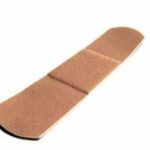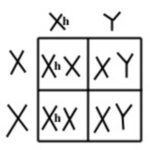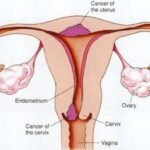Though the fight against Hemophilia only began in recent years, evidence of the disorder can be traced back to ancient times. Jewish texts from the second century AD show a history of uncontrollable bleeding: “Rabbinical rulings exempted male boys from circumcision if two previous brothers had died of bleeding after the procedure. (Hemophilia Ontario)”. In the twelfth century AD, a Jewish physician by the name of Moses Maimonides enacted this law for sons of women who had married twice, which seems to suggest awareness of the hereditary nature of the disorder; now, half-brothers could evade circumcision instead of just brothers. In the eleventh century AD, an Arabic surgeon named Albucasis also described similar phenomenon where males died after seemingly minor injury.
A Philidelphia physician, Dr. John Conrad Otto, provided the first modern description of Hemophilia in 1803. In an article written by Otto, entitled “An account of an hemorrhagic disposition existing in certain families”, the three main features of Hemophilia are clearly outlined; Otto describes a condition which is hereditary, occurs in males, and causes excessive bleeding. However, it wasn’t until 1828 that the disorder was first called Hemophilia; Hopff, a student at the University of Zurich, trying to describe the inherited bleeding disorder, labeled it as haemorrhaphilia. The name was later changed to hemophilia.
The first treatment of Hemophilia came in 1840, when Samuel Armstrong Lang and his assistant performed the first successful blood transfusion to treat Hemophilia at St. George’s Hospital Medical school in London. This would be the cure for Hemophilia until its underlying cause was better understood, which wouldn’t happen for another 99 years.
In 1939, Kenneth Brinkhous of the University of North Carolina, described what he called antihemophilic factor, now known as Factor VIII, a protein in the blood that allows blood to coagulate; he claimed that people with Hemophilia lacked the ability to create it. Brinkhous and his colleagues would develop the activated partial thromboplastin time (APTT) testto detect blood disorders; a test that is still commonly used today, though this wouldn’t happen until 1952. The test measures the levels of various coagulation factors in the blood, including Factor VIII, by measuring how much time it takes for the blood to clot:
The APTT procedure requires placing a designated volume of platelet poor plasma (PPP) into a reaction well followed by a designated volume of cephaloplastin reagent and allow the mixture to come to 37 oC. Three minutes is ample time for step. The final step is to add a designated volume of calcium chloride reagent. The ensuing reaction is watched and the time recorded when the fibrin clot develops (Williams).
Brinkhous eventually learned how to purify and concentrate Factor VIII, which allowed it to be much more effective and efficient. Another important discovery of Brinkhous, was that Hemophilia can also be developed in females, though very rarely. For a female to develop the disorder, both parents need to have it themselves. Because it is so rare, Hemophilia is often deemed a male disorder. In addition, Brinkhous became a leader in explaining von Willebrand’s disease, another coagulative disorder marked by an inability to produce Factor VIII, as well as another coagulative factor known as von Willebrand Factor.
In 1944, an American biochemist by the name of Edwin Cohn developed a process known as fractionation: “the process of separating plasma into its different components (Funk & Wagnalls)”. Though not initially intended to help treat Hemophilia, fractionation can filter out various coagulation factors in plasma, including Factor VIII.
In the same year, researchers came across a case where, when the blood of two different hemophiliacs were mixed, both were able to clot. The reasons for this remained a mystery until 1952, when a group of researchers in Oxford England discovered that there were two types of Hemophilia. The researchers ran blood tests on Stephen Christmas, a young boy from Toronto with Hemophilia. The tests showed that Stephen was not deficient in Factor VIII, but rather, a different coagulative blood factor now known as Factor IX. Needless to say, Factor IX is also detectable by the APTT test, developed by Brinkhous in the same year. This new type of Hemophilia, marked by a deficiency of Factor IX, is known as Hemophilia B or “Christmas Disease“; the more common type of Hemophilia is now known as Hemophilia A. The two patients whose blood were mixed were able to clot because the deficient factor of one was present in the other.
In 1954, a highly purified form of Factor VIII from pig’s blood, known as Porcine Factor VIII, was identified and extracted (from pigs). Porcine Factor VIII can be very helpful in controlling bleeding of people with Hemophilia A. However, recognized by the body as an antigen, it is only effective for certain patient’s whose antibodies don’t react well to it. Also, it tends to cause allergic reactions and temporary drops in platelet counts, so it is not used as a routine treatment.
People with Hemophilia often bleed in the joints, as joints contain very large numbers of blood vessels. When bleeding occurs in a joint, more blood vessels are created, making bleeding in the joint easier in the future. The vessels are contained in the synovium, which swells up as the vessels increase in numbers. The enzymes produced by the swollen synovium eat away the cartilage in the joint. The more the joint gets damaged, the more bleeding occurs, and the joint gets worse and worse. In 1958, experiments in prophylaxis were done in Sweden for patients with Hemophilia A: “Prophylaxis, as it applies to the treatment of hemophilia (either VIII or IX deficiency), is the regular infusion of clotting factor two or three times a week. It is given this way to prevent joint bleeding (Sylvia)”. The studies showed that boys with Hemophilia A, treated through prophylaxis from a young age, rarely bled and showed little to no joint damage.
In the early 1960’s, Dr. Murray Thelin, a Hemophilia A patient and scientist at Hyland Laboratories, used a process of freezing and thawing plasma to produce a layer highly concentrated with Factor VIII. Thelin first tested the new concentrate by injecting himself with it. The concentrate is a powder form, which can be refrigerated and dissolved in sterile water when needed; with it, Hemophilia A patients can easily treat themselves at home. In 1966, Kenneth Brinkhous, and Edward Shanbrom of Hyland Laboratories, modified Thelin’s process, creating a concentrate with a clotting power 100 times greater than donor plasma containing Factor VIII. Later that year, Hyland Laboratories announced the commercial availability of the new concentrate. Three years later, in 1969, a concentrate of Factor IX was made commercially available for patients with Hemophilia B.
In 1977, Professor Pier Mannucci of the University of Milan, discovered that a human pituitary hormone called desmopressin can elevate levels of Factor VIII in the blood. While it is unclear why this occurs, desmopressin remains a treatment option for people with mild forms of Hemophilia A.
In 1979, a company called Cutter Biological developed their own concentrated Factor VIII with plasma from the Canadian Red Cross. Around this time, several other companies emerged with their own versions of the concentrate. However, the concentrates produced by many of these companies would result in disaster for many hemophiliacs. Much of the earlier concentrates were produced without heat-treating, a process used to rid of HIV, among other harmful substances that may be present in Factor VIII or IX concentrates. As a result, many hemophiliacs who recieved treatment from around this time developed HIV: “From the late 1970s to the mid-1980s, about half of all people with hemophilia became infected with HIV through blood products. Many of these people have developed AIDS. Currently, 10% to 15% of persons with hemophilia are infected with HIV (National Hemophilia Foundation)”. Many patients also developed Hepatitis C from the tainted blood. The first heat treatment occurred in 1983, which became a standard practice over the next couple years, and more efficient processes were underway to make transfusions safer.
The gene for Factor VIII, located on the X-chromosome, was isolated and extracted from human cells in 1984. From there, it was mixed with cultures of hamster cells which could be made to produce it in large quantities. The produced Factor VIII was then removed from the hamster cells and purified; it was now ready to be used for treatment. Factor VIII produced in this way is known as recombinant Factor VIII. This type of Factor VIII is now preferred over Factor VIII from donor plasma because it is free from viruses such as HIV: “The production of factor VIII by recombinant DNA technology eliminates even the theoretical possibility of the transmission of viruses from plasma. Its approval is a milestone in the history of treatment of hemophilia (Revelle).” Soon, recombinant Factor IX was introduced as well. Recombinant Factor VIII was first tested on a Canadian patient in 1989, and was approved by the Food and Drug Administration (FDA) for licensing in 1992. Canada would be the first country to make it available to all in 1993. Licensing of recombinant Factor IX would not occur until 1997.
In 1997, Dr. Ian Wilmut of Rosen Institute in Scotland, along with his assistants, cloned two sheep that were named Molly and Polly (the first successful clone of a sheep, Dolly, occurred one year earlier). The original cell to be cloned was taken from a 26-day old sheep fetus, and to it, the researchers added the gene for Factor IX and linked it with a sheep gene that increases milk production. The researchers also added a marker to the cell, a gene which causes resistance to antibiotics. Once the cells were made to multiply, several were placed into sheep eggs, replacing the nuclei. Each egg was grown to an embryo state, and 62 made it to be implanted into surrogate mothers. Of these 62, only six were born. Three of the six contained the human Factor IX gene as well as the marker, but one of the sheep died, leaving only Molly and Polly. The hope was that these sheep could produce significant levels of Factor IX in their milk, and could breed a whole generation of sheep, all producing it as well: “The new work could prove that cloning is an efficient way to create herds of cows or flocks of sheep that act as drug-making factories (Recer)”.
In the same year, Justice Horace Krever issued what was called Krever’s Final Report, where he reported the ways the Canadian Blood System failed to prevent Hemophilia patients from contracting deadly illnesses, such as HIV, thorough blood transfusion (in the 1980’s). In the report, Krever also identifies many individuals and their responsiblities in the tragedy. He also recommends compensation to victims, as well as new practices to make blood safer, many of which were already in the works at the time. The report was presented to the Prime Minister, who presented it publicly five days later.
In 2000, Bayer HealthCare introduced a second generation recombinant Factor VIII, also known as Kogenate FS. This new form has up to 400 times the concentration of Factor VIII than does human plasma, and is safer, more convenient and efficient. In 2001, however, the Bayer company, who now supplied 30% of the market for genetically engineered Factor VIII, ran into producion problems which led to a 16 month, worldwide shortage of Factor VIII. Though the FDA concluded that the product itself was safe, they found several other problems within the Bayer facility:
The FDA cited Bayer for multiple problems: The company allegedly failed to properly investigate incidents of bacterial contamination, produced batches of Factor VIII whose potency could not be assured, had inadequate employee training and was sloppy in its record-keeping (Sabin).
From there, the Bayer company updated their plant, and were back in normal production within the next couple years. Currently, work is being done by Bayer, as well as other companies, to produce third generation recombinant Factor VIII, an even more concentrated and purified form than those preceding.
Hemophilia A makes up 80% of all Hemophilia cases. One in 10,000 males will develop Hemophilia A, and one in 34,000 male will develop Hemophilia B, or “Christmas Disease”. The disease can occur in females, but very rarely. Because hemophiliacs cannot create factor VIII or IX on their own, they each need a constant supply of one or the other to prevent episodes of life-threatening bleeding. The need for such large amounts of these coagulation factors caused many different technologies and methods of obtaining them to come about, and new techniques are still being developed today.
SOURCES:
Bayer HealthCare; 2006; Kogenate® FS Antihemophilic Factor (Recombinant), Formulated with Sucrose; http://www.kogenatefs.com/; http://www.kogenatefs.com/HCP_A_ProdMono.cfm; Nov. 29, 2006.
Canadian Hemophilia Society; 2006; Early Milestones; http://www.hemophilia.ca/; http://www.hemophilia.ca/en/9.1.php; Nov. 2, 2006.
Carson-DeWitt Rosalyn, MD; Hemophilia; http://healthlibrary.epnet.com/; http://healthlibrary.epnet.com/GetContent.aspx?token=9cc295f8-f3b0-4b15-99b3-beb1e6cbe599&chunkiid;=11804; Nov. 21, 2006.
Feldman Brian M., MD; 2000; Preventing Joint Damage from Hemophilia; http://www.jrheum.com/; http://www.jrheum.com/abstracts/editorials/200341.html; Nov. 27, 2006.
Flieger Ken; 2001; Outlook Brighter for Youngsters with Hemophilia; http://www.fda.gov/; http://www.fda.gov/bbs/topics/CONSUMER/CON00240.html; Nov. 27, 2006.
Funk & Wagnalls® New Encyclopedia; 2006; BLOOD; http://www.history.com/; http://www.history.com/encyclopedia.do?articleId=203192; Nov. 21, 2006.
Giangrande Dr. Paul, World Federation of Hemophilia; 2004; History of Hemophilia; http://www.wfh.org/; http://www.wfh.org/2/1/1_1_3_HistoryHemophilia.htm; Nov. 12, 2006.
Hemophilia Ontario; Unknown; Justice Krever Issues Final Report; http://www.hemophilia.on.ca/; http://www.hemophilia.on.ca/Support/Reports/final_krever_report.htm; Nov. 29, 2006.
Jaye Michael, De La Salle Henri, Schamber Fabienne, Balland Alain, Kohli Vipin, Findeli Annie, Tolstoshev Paul, Lecocq Jean-Pierre; 1983; Isolation of a human anti-haemophilic factor IX cDNA clone using a unique 52-base synthetic oligonucleotide probe deduced from the amino acid sequence of bovine factor IX; http://www.pubmedcentral.nih.gov/; http://www.pubmedcentral.nih.gov/articlerender.fcgi?artid=325887; Nov. 21, 2006.
Kugler Mary; 2005; Christmas Disease; http://rarediseases.about.com/; http://rarediseases.about.com/cs/hemophilia/a/122100.htm; Nov. 21, 2006.
National Hemophilia Foundation; 2006; HIV/AIDS; http://www.hemophilia.org/; http://www.hemophilia.org/NHFWeb/MainPgs/MainNHF.aspx?menuid=43&contentid;=39&rptname;=bleeding; Nov. 27, 2006.
Recer Paul; 1997; Lambs Cloned with Human Gene so Milk Carries Blood-clot Protein; Associated Press; Dec. 18, 1997.
Revelle Monica; 1992; Untitled; http://www.fda.gov/; http://www.fda.gov/bbs/topics/NEWS/NEW00312.html; Nov. 29, 2006.
RxMed; Unknown; The Comprehensive Resource for Physicians, Drug and Illness Information; http://www.rxmed.com/; http://www.rxmed.com/b.main/b2.pharmaceutical/b2.1.monographs/CPS-%20Monographs/CPS-%20(General%20Monographs-%20O)/OCTOSTIM.html; Nov. 27, 2006.
Sabin Russel; 2002; Critical Vaccines, Medicines Run Low; Chronicle Medical; Feb. 10, 2002.
Spartanburg Herald-Journal; 2006; Blood Transfusion; http://www.goupstate.com/; http://www.goupstate.com/apps/pbcs.dll/section?category=NEWS&template;=wiki&text;=
blood_transfusion; Nov. 12, 2006.
Sylvia Jordan, RN, et. al; 1999; Prophylaxis: A Fact Sheet for Parents; http://www.hemophilia.org/; http://www.hemophilia.org/resources/prophylaxis.htm; Nov. 21, 2006.
Williams Whitney; 2006; CLS 2523 BASIC CONCEPTS OF HEMATOLOGY; http://www.clt.astate.edu/; http://www.clt.astate.edu/wwilliam/hem_i_hemostasis.htm; Nov. 21, 2006.





